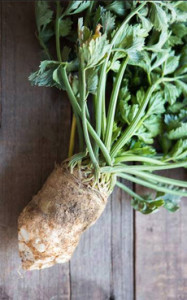Celeriac, Celery Root, Knob Celery, A Root By Any Other Name…
 [1] Call it celeriac or celery root: It’s not a beauty, but you’ll be hooked by its delicious, distinctive flavor (photo © The Chef’s Garden_.
|
If you were asked to name root vegetables, you probably would overlook celery root, even though it has “root” in its name.
Celery root is a large, gnarled globe—perhaps the least attractive item in the produce section. But peel away the skin and you’ll discover creamy flesh like a parsnip’s, to which it is related. Its botanical family, Apiaceae—commonly known as the carrot or parsley family—includes numerous* well-known vegetables. While not a relative, it can be cooked in the same way as potatoes. We grew up in an era and in a town with a wealth of old-school French restaurants, presenting the cuisine of Escoffier and other seminal French chefs. Our favorite appetizer was céleri remoulade, a classic French first course. To make it, the raw celery root knob is peeled and julienned (cut into matchsticks). It is then dressed with rémoulade sauce, a homemade mayonnaise flavored with Dijon mustard. It was served to us in a lettuce cup, sometimes atop greens. Think of a gourmet cousin of coleslaw. We couldn’t get enough of it. There’s a recipe for Chicken Thighs With Mashed Celery Root below. Called céleri in French and celeriac in English, the vegetable is also called celery root, knob celery, and turnip-rooted celery. It can be eaten raw or cooked. Apium graveolens var. Rapaceum has a crisp, apple-like texture with bright white flesh. The firm, juicy flesh has a mild herbaceous quality with celery-like undertones. Celery root can be a non-starch substitute for potatoes: mashed, French-fried, and almost any other way. Celery root is available year-round, with a peak season in late fall and winter. Nutritionally, it is an excellent source of dietary fiber and potassium, with significant amounts of vitamins B6 and C. It has just 66 calories per cup. One of the oldest root vegetables in recorded history, it grew wild in the Mediterranean Basin and in Northern Europe, but was considered difficult to grow. Farmers worked to master it, and it became culinarily important during the Middle Ages. |
|
|
Celeriac developed from the same wild plant as the familiar long-stalk green celery, but you’d never know from looking at them that they are kin. Over the millennia, different strains of the plants were developed for different reasons, some focusing on the root, others on the stems or leaves. *Some other cousins include angelica, anise, caraway, celery, chervil, coriander/cilantro, cumin, dill, fennel, lovage and sea holly. Thanks to Good Eggs, the finest grocery purveyor in San Francisco, for this recipe. |
||
|
Ingredients For 2 Servings
†Tired of kale? Substitute broccoli rabe (rapini), collard greens, kohlrabi leaves, mustard greens, red cabbage or Swiss chard. ‡There are more than 50 varieties of kale, of which four are most often found in the U.S. Curly kale is the variety typically found in grocery stores. You may have to hit farmers markets or specialty produce stores for the others: lacinato kale (also called black kale, dinosaur kale, and Tuscan kale, among other names), redbor kale (ornamental kale, which is equally edible), and red Russian kale. |
 Crispy chicken thighs, creamy mashed celery root and good-for-you greens. Photo courtesy Good Eggs | San Francisco. |
|
|
**We don’t love vague measurements like a bit, a handful, a spoonful, a smidge. They’re imprecise and subjective. The best explanation is that the exact quantity isn’t important: Use more or less as you like. Write down how much you use when you add the ingredient, and then note afterward how much you’d use the next time you make the recipe. ________________ Preparation 1. PREHEAT the oven to 400°F with an oven-safe pan inside (cast iron, french oven, or deep fry pan). Fill a large pot about halfway full with water for the stovetop, add a handful of salt and turn the heat to high. Salt and pepper the chicken thighs liberally. 2. PREP the celery root by slicing off the top and bottom and peeling off the fibrous outer skin. Cut into 1-inch chunks and add to the pot of water. Bring to a boil and cook for 15 minutes. When the oven is hot… 3. REMOVE the pan and add the chicken thighs, skin side down. Place the pan back in the oven for 25-30 minutes, then gently test for doneness by pricking with a small, sharp knife. They’re done when the chicken juices run clear. TIP: For extra crispy skin, preheat a cast-iron skillet in the oven instead of a baking pan—and be prepared to remove it with silicone oven mitts or potholders. 4. CHECK the celery root for doneness; it’s finished when the cubes are tender. Drain and place the cubes in a mixing bowl along with the butter, herbs, salt and pepper. Using a fork or the back of a spoon, mash all of the ingredients together until you have your preferred consistency of mashed potatoes. Season with salt and pepper to taste. 5. REMOVE the finished chicken from the pan. Pour off about half the pan drippings, add the kale and toss with tongs, making sure the greens are coated in the drippings. Return the pan with the kale to the oven for about 5-7 minutes to cook the kale quickly. Once the kale is done, dress it with a squeeze of lemon and serve alongside the chicken and celery root. NOTE: Like an apple, celery root will discover with prolonged exposure to air. To serve it raw, blanched briefly in acidic water (with lemon juice). |
||
